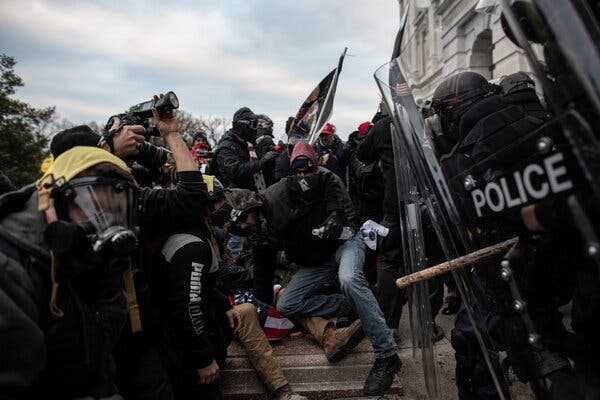Officer Brian D. Sicknick died a day after the Capitol riot. Another man initially charged in the assault was sentenced to time served.
-
Send any friend a story
As a subscriber, you have “>10 gift articles to give each month. Anyone can read what you share.
Give this articleGive this articleGive this article

Washington’s medical examiner found that Officer Brian D. Sicknick died of natural causes but noted that he had engaged with rioters on Jan. 6 and that “all that transpired played a role in his condition.”
With a sea of uniformed police officers looking on, a New Jersey man who pleaded guilty to shooting pepper spray into the face of Officer Brian D. Sicknick during the Jan. 6, 2021, storming of the Capitol was sentenced on Friday to nearly seven years in prison.
The 80-month sentence handed down against the man, Julian Khater, brought an end to one of the wrenching cases involving Officer Sicknick, who died one day after he was doused with pepper spray in the melee outside the Capitol.
At the same hearing, George Tanios, a second man who was accused in the attack, was sentenced to time served, having already spent five months in jail as his case moved through the courts. In July, Mr. Tanios pleaded guilty to misdemeanor charges after the government agreed to drop an assault count against him.
While early reports suggested that Officer Sicknick died of his injuries, an autopsy later showed that he died of natural causes, after suffering multiple strokes that were not directly related to the violent pro-Trump riot. Still, prosecutors have noted in court filings that Washington’s medical examiner determined that Officer Sicknick had engaged with rioters on Jan. 6 and that “all that transpired played a role in his condition.”
The sentencing hearing, in Federal District Court in Washington, was marked by the presence of perhaps 50 of Officer Sicknick’s colleagues in the U.S. Capitol Police — so many that several dozen of them were asked to move to an overflow room. The hearing also featured emotional testimony from several members of Officer Sicknick’s family.
Understand the Events on Jan. 6
- Timeline: On Jan. 6, 2021, 64 days after Election Day 2020, a mob of supporters of President Donald J. Trump raided the Capitol. Here is a close look at how the attack unfolded.
- A Day of Rage: Using thousands of videos and police radio communications, a Times investigation reconstructed in detail what happened — and why.
- Lost Lives: A bipartisan Senate report found that at least seven people died in connection with the attack.
- Jan. 6 Attendees: To many of those who attended the Trump rally but never breached the Capitol, that date wasn’t a dark day for the nation. It was a new start.
Gladys Sicknick, Officer Sicknick’s mother, told Mr. Khater that he had gone after her son “like he was an animal,” adding that whatever penalty he received was “not enough in my eyes.”
Mrs. Sicknick also had lacerating words for the larger mob of rioters who had laid siege to the Capitol.
“All of you bear responsibility for the injuries sustained by Brian’s fellow officers — the broken bones, head trauma and the continuing mental anguish they suffer and will endure for the rest of their lives,” she said. “Imagine the emotional pain that would cause someone to take his own life. Four officers committed suicide. You and your ‘movement’ caused their deaths.”
Officer Caroline Edwards, who was injured in the same attack and testified about her experience to congressional investigators, also appeared in court to deliver remarks to Judge Thomas F. Hogan, who presided in the case.
“Sometimes when I close my eyes I can still see his face, white as a sheet,” Officer Edwards said of Officer Sicknick, adding, “I would give anything to take the pain away from the Sicknick family and my fellow officers.”
Mr. Khater’s sentence was one of the longest given to any of the 950 people charged so far in connection with the Capitol attack. The most severe sentences, which have ranged from seven-and-a-half years to 10 years in prison, have been handed down to defendants accused of assaulting police officers.
Officer Sicknick was attacked with chemical spray at a key moment in the riot — just as the mob was overrunning the police at bike rack barriers on the west side of the Capitol.
In court papers filed before the hearing, Mr. Khater said he had no intention of entering the Capitol on Jan. 6 and only went to Washington that day because Mr. Tanios invited him to tag along to a rally by President Donald J. Trump. Mr. Tanios, who is from West Virginia, later admitted buying two cans of bear spray and two canisters of a less potent pepper spray before the trip to Washington, but said they were only for self-protection.
In his papers, Mr. Khater acknowledged that he used pepper spray against at least three officers, including Officer Sicknick, but explained that he had merely given into “his anxiety” in “a dangerous and chaotic atmosphere.”
When Mr. Khater addressed Judge Hogan, he noted that he had already been in custody for 684 days — “a long, agonizing, but humbling experience,” as he put it.
“What happened on Jan. 6 — there’s no words for it,” he said. “It’s unfortunate, and I wish I could take it all back.”
Just before he handed down Mr. Khater’s sentence, Judge Hogan said he could not understand why he had joined the mob and attacked officers who presented no threat to him.
“It just does not compute with me, this type of activity, and people thinking they can do this because they disagreed with the results of the election,” he said.
Source: nytimes.com



